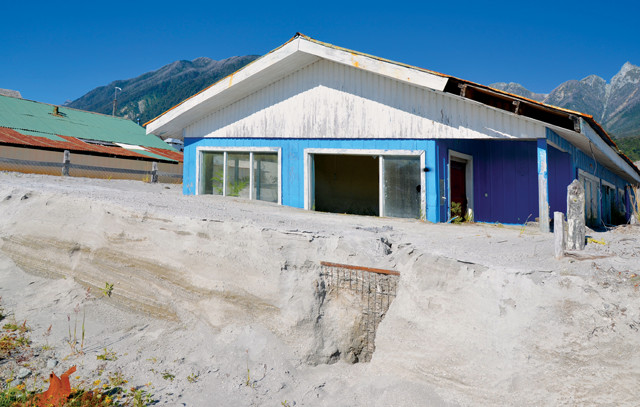
by Mary Caperton Morton Friday, March 6, 2015

The town of Chaitén, Chile, was buried under more than a meter of ash during the 2008 eruption of the nearby Chaitén volcano, long thought to be dormant. Credit: Brent Alloway.
When the Chaitén volcano erupted in southern Chile on May 2, 2008, the explosive event took local residents — and geologists — by surprise: Previous studies concluded that the mountain had been quiet for more than 10,000 years. Now, a detailed look at sediments preserved in a nearby lake reveals a much more active history for Chaitén, a finding that may impact the proposed rebuilding of the ash-filled town.
Before the 2008 eruption, Chaitén had not been well-studied, says Sebastian Watt, a volcanologist at the University of Birmingham in England, who was not involved in the new study. “The first major study of this region was published in 2004,” he notes. “By looking at road cuts, [that study] found evidence of only one past eruption that was dated to around 10,000 years ago.” But the impacts of the 2008 eruption brought renewed attention to the volcano’s past.
Following the initial blast, the town of Chaitén was buried under more than a meter of ash; it was then flooded by heavy rainfall and inundated by the Chaitén River as it carved a new channel through the ash. Evacuations emptied the town of its 5,000 residents, and only one person was killed. But in the aftermath, the Chilean government proposed relocating the town to a safer location 10 kilometers to the north, a suggestion that was met with resistance from town residents.
“The 2008 Chaitén eruption made international headlines at the time because, in the eyes of the media, it was an out-of-the-blue event that occurred without warning and which posed a significant threat to Chaitén township and those communities downwind in Chile and Argentina,” says Brent Alloway, a volcanologist at Victoria University of Wellington in New Zealand and a co-author of the new study in Geology.
The event also turned heads in the geologic world, because explosive eruptions of rhyolitic volcanoes like Chaitén are rare; the last major event of this type occurred in Alaska in 1912. “It was an unprecedented scientific opportunity” to study a rhyolitic eruption, Alloway says. In many ways, including its magnitude and its chemical and physical characteristics, the Chaitén eruption was similar to what volcanologists expect from future eruptions in South America, Alaska and other volcanically active areas, he says.
For the new study, Alloway and colleagues turned to sediments preserved on the bottom of Lago Teo, a small glacially carved lake located 7 kilometers southwest of Chaitén. Unlike the rocks exposed in road cuts, the lake sediments contained large amounts of organic matter sandwiched between the ash layers, which allowed the researchers to identify many distinct volcanic events and to radiocarbon date individual ash layers with a high degree of accuracy, Alloway says.
The researchers found that Chaitén has erupted at least 26 times in the past 10,000 years. In addition to the 2008 eruptive event, three eruptions were noted between A.D. 600 and 850 as well as another in about A.D. 420 — suggesting an average eruptive recurrence interval of roughly 200 years over the last 1,000 years.
“This study highlights the poor resolution we have for the [eruptive] histories of many volcanoes,” Watt says. “Unless we have detailed lake or marine sediment records that preserve a high-resolution archive of past activity, it’s likely that we’re only seeing the largest events.”
The Lago Teo records clearly indicate that it’s not a matter of if another eruption will occur at Chaitén, but when, Alloway says. “At present, there is a lot of community resistance to relocating the town to the government-recommended alternative site,” he says, noting the new findings will need to be carefully considered by both the Chilean authorities and the local community as they continue with restoration and rebuilding.
“Resolution between residents and governmental authorities regarding the proposed relocation of Chaitén township [is becoming] more and more difficult to achieve,” Allowa
© 2008-2021. All rights reserved. Any copying, redistribution or retransmission of any of the contents of this service without the expressed written permission of the American Geosciences Institute is expressly prohibited. Click here for all copyright requests.